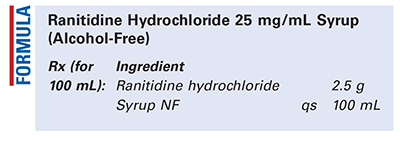US Pharm. 2017;42(12):47-48.

Method of Preparation: Calculate the quantity of each ingredient for the amount to be prepared. Accurately weigh or measure each ingredient. Mix the ranitidine hydrochloride with a small quantity of syrup to form a smooth paste. Geometrically, add additional syrup to final volume and mix well. Package and label.
Use: Ranitidine hydrochloride is used in the relief of heartburn and acid indigestion; it is also used for short-term and maintenance therapy for duodenal ulcer, gastric ulcer, gastroesophageal reflux, active benign ulcer, erosive esophagitis, and pathological hypersecretory conditions.
Packaging: Package in tight, light-resistant containers.
Labeling: Keep out of reach of children. Keep refrigerated. Shake well. Discard after ____ [time period].
Stability: A beyond-use date of up to 153 days has been used for this preparation.1,2
Quality Control: Quality-control assessment can include weight/volume, pH (6.7-7.5), specific gravity, active drug assay, color, clarity, rheologic properties/pourability, physical observation, and physical stability (discoloration, foreign materials, gas formation, mold growth).3
Discussion: In many cases, it is not advisable to administer a medication containing alcohol to pediatric patients, or even to adults in certain situations. The formula presented here contains no alcohol, and it may be administered to patients who require an alcohol-free medication.
Ranitidine hydrochloride (Zantac, C13H22N4O3S.HCl, MW 350.86) occurs as a white to pale yellow, crystalline, practically odorless powder that is sensitive to light and moisture. It melts at about 140°C with decomposition. It is highly soluble in water and sparingly soluble in alcohol.1 Ranitidine Oral Solution USP has a pH of 6.7 to 7.5.
Ranitidine, which was discovered in 1976, came into commercial use in 1981. It is on the World Health Organization’s List of Essential Medicines, which includes the most effective and safest medicines meeting a health system’s needs. Ranitidine is available as a generic medication. In children, the use of gastric-acid inhibitors has been associated with an increased risk of the development of acute gastroenteritis and community-acquired pneumonia.
Commercially manufactured ranitidine hydrochloride syrup (Zantac) 15 mg/mL contains alcohol 7.5%, peppermint flavor, disodium hydrogen phosphate anhydrous, sodium dihydrogen phosphate dihydrate, saccharin sodium, sorbitol solution 70%, and purified water. It is a white to pale yellow liquid that smells of mint and is marketed in a brown glass bottle containing either 100 mL or 300 mL of solution.
Pediatric oral dosing of ranitidine in children aged 1 month to 16 years has been stated to be 2 to 4 mg/kg/day divided twice daily (maximum of 300 mg per day), with a maintenance dosage of 150 mg per day for gastric or duodenal ulcer. For GERD and erosive esophagitis, the dosage is 4 to 10 mg per day divided twice daily, with a maximum of 300 mg/day for GERD and 600 mg/day for erosive esophagitis.4 The formulation provided here may be used in patients who are unable to swallow the oral solid dosage form (tablets) of the drug.
Syrup (simple syrup) is a clear, sweet vehicle used as a sweetening agent and as the base for many flavored and medicated syrups. It contains 85% w/v sucrose in purified water and has a specific gravity of not less than 1.30. Syrup is generally self-preserving as long as the sucrose concentration is maintained sufficiently high. Preferably, syrup is prepared without the use of heat, but it may be prepared with boiling water. It should be stored in tight containers, preferably in a cool place.1 It should be noted that Syrup NF may differ among providers and, in some cases, may contain a preservative or other ingredients. In order for the beyond-use date noted above to be used, the product should be Syrup NF and should be unmodified. Also note that white syrup or corn syrup purchased in grocery stores may differ from Syrup NF.
To make an alcohol-free preparation for pediatric use, numerous vehicles and suspending vehicles are available; there are many that are flavored and alcohol free. The vehicle presented here, syrup, is one of the most basic vehicles, but it has been studied and the results published. If an alternative vehicle is used, note the pH of Ranitidine Oral Solution USP, which is between 6.7 and 7.5.
REFERENCES
1. U.S. Pharmacopeia/National Formulary [current revision]. Rockville, MD: U.S. Pharmacopeial Convention, Inc; November 2017.
2. Schlatter J, Saulnier JL. Stability of ranitidine oral solutions prepared from commercial forms. Eur Hosp Pharm. 1998;4:23-26.
3. Allen LV Jr. Standard operating procedure for performing physical quality assessment of oral and topical liquids. IJPC. 1999;3:146-147.
4. Lexi-Comp’s Pediatric Dosage Handbook. 10th ed. Hudson, OH: Lexicomp; 2003:972-975.
To comment on this article, contact rdavidson@uspharmacist.com.






